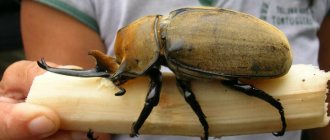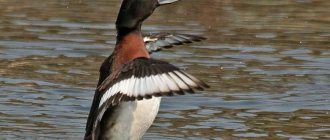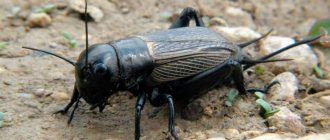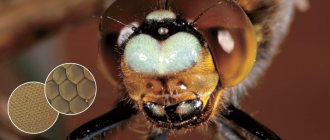03.06.2020
Despite the fact that insects seem to be rather primitive creatures, curious researchers often have questions. How does their nervous system work? How do individual species organize hierarchy? If they are so organized, does that mean they have a brain? And if there is a brain, is it different in different types of insects? In this article we will try to answer these questions.
- Insect intelligence research
- Brain structure
- Features of the insect brain
The fly has a unique brain
Flies were found to process 100 frames per second.
And this allows them to detect an obstacle during flight within a few milliseconds (a millisecond is one thousandth of a second). In particular, the researchers focused their attention on optical flows, which they called "optical field flows." It appears that this optical field is processed only by the first layer of neurons. They process the “rough” source signal from each fly “pixel”. And they forward the processed information to the next layer of neurons. And, according to the researchers, there are only 60 of these secondary neurons in each hemisphere of the fly brain. However, the fly brain manages to reduce or fragment the field of view into many sequential “motion vectors” that give the fly a vector of direction of movement and “instantaneous” speed. And what’s interesting is that the fly sees it all! We, people (and not everyone), know what a vector and instantaneous speed are. And the fly, naturally, has no idea about these things. And such abilities of the fly’s brain to process a huge amount of information can only be envied. Why do we see only about 50 frames per second, and the fly 100? It's hard to say, but there are reasonable guesses on this matter. How does a fly fly? Almost “instantly”, with enormous acceleration. We could hardly withstand such an overload. But it is possible to create a robotic brain that is as fast as the brain of a fly in processing information flows.
To try to understand how a tiny fly brain can process such a huge amount of information, researchers in Munich have created a “flight simulator” for a fly. The fly could fly, but was kept on a leash. Electrodes recorded the response of the fly's brain cells. And researchers tried to understand what happens in the fly’s brain during flight.
The first results are obvious. Flies process images from their fixed eyes very differently than humans do. When a fly moves in space, “optical flux fields” are formed in its brain, which give the fly the direction of movement.
How would a person see it? For example, when moving forward, surrounding objects would instantly scatter to the sides. And objects in the field of view would appear larger than they actually are. And it would seem that nearby and distant objects move differently.
The speed and direction with which objects flash before the eyes of a fly generate typical patterns of motion vectors - field flows. Which, at the second stage of image processing, reach the so-called “lobula plate” - the center of vision of a higher level. In each hemisphere of the fly's brain there are only 60 nerve cells responsible for vision. Each of these nerve cells responds only to a signal with a certain intensity.
But for the analysis of optical flows, information coming from both eyes simultaneously is important. This connection is provided by special neurons called “VS cells”. They allow the fly to accurately assess its location in space and flight speed. It appears that the “VS cells” are responsible for sensing and responding to the torque applied to the fly during its flight maneuvers.
Constant construction
The brain changes not only during evolution, but also throughout a single life. The brain of a fetus in the womb is constantly developing, and the number of its neurons increases many times over. The brain of a newborn contains even more neurons than the brain of an adult! That is, some of these cells are then removed by the body. However, the main difference between the newborn brain and the adult brain is the number of connections between neurons. A baby has much less of them, but from the very first days of life it is constantly growing. This is what makes learning possible. It has many neurons. In old age, brain development slows down.
Anatomy of an insect
The general plan of the fly is the same as that of most dipterous insects. They have:
The abdomen includes the digestive and reproductive systems. This applies to all types of flies. The chest is equipped with muscles that are necessary for flight. The insect also has 3 pairs of legs.
The head is “equipped” with large faceted eyes, a proboscis and antennae. As for the internal structure, the brain is located inside the cranium. Of course, it is not the same as in humans and mammals.
What are IQ tests for?
Intelligence quotient (IQ) tests do not measure how smart a person is. They only make it possible to understand how developed certain abilities are - speech, logic, the ability to remember... We can say that these tests measure the level of specific abilities (in linguistics, mathematics...). But we are talking only about the level that exists in specific areas and at a specific time. But it is necessary that these opportunities be adapted to the needs of this or that individual and to the needs of the environment in which he lives.
Geniuses use the right hemisphere more
Brain structure
When thinking about the brain, many people see a picture of a round substance with convolutions pop up before their eyes. With a fly things are different. The Diptera brain consists of 3 sections, namely:
- tritocerebrum;
- protocerebrum;
- deutocerebrum.
Despite its fairly simple structure, the brain is responsible for the functioning of the entire body. At the same time, the fly is not able to think. She acts instinctively.
Important: in the body there are nerve nodes called ganglia, which connect to the “brain”.
Protocerebrum
This is the largest part of the brain, responsible for coordinating any life process of an insect. This part of the “control center” contains a huge number of neurons. They are responsible for analyzing and processing the information received.
Due to the arrangement of cells in the outer layer and the fibers leading to them, the fly’s brain can be compared to the control organ of a human or animal.
Inside the protocerebrum there are additional sections. Which are divided into:
- central body;
- intercerebral part;
- protocerebral lobes;
- protocerebral pons;
- ventral bodies;
- optic lobes;
- stalked bodies.
Important: bees and ants have similar additional sections.
Deutocerebrum
The section is located in front of the tritocerebrum. Responsible for the nerve endings going to the antennae. "Antennae", the only fibers extending from the secondary brain. In most cases, they begin with roots:
In some species of flies these roots are not observed.
Deutocerebrum differs from protocerebrum in its simplicity. The structure diagram corresponds to a normal ganglion. This can only be explained by the fact that this section is the nerve center of only one segment - the mustache.
Tritocerebrum
The department is usually called the tertiary brain. His position is clear. The tritocerebrum is located between the other sections. However, the brain does not have a specific shape. The only thing we can say with certainty is that it is divided into;
There is a small jumper between the two halves. It passes under the intestines.
The main function of the tritocerebrum is to control the mouth and upper lip. The second may be absent in some types of flies.
Body parts and integument
Insects are distinguished by an enviable species diversity: approximately 1.5 million. Moreover, this figure is minimal. Despite this, they all have a common structure plan. The body of insects is clearly divided into three sections. These are the head, chest and abdomen. The middle section bears three pairs of limbs and wings.
The internal organs of insects are reliably protected by the external skeleton - the cuticle. Its outer layer is formed by fatty substances that prevent excessive moisture loss. Odorous or poisonous glands are also located here. The color of the insect depends on the type of pigments found in the middle layer of the cuticle.
How does the control center work?
At first glance, it seems that the fly's brain is simple and is not capable of performing complex operations. Even “experienced” scientists are surprised at his work.
An experiment was conducted on flies at the University of California. As a result, it became clear that the “control center” of the insect determines the speed of the body moving towards the pest. Thanks to this, the fly understands in which direction it needs to move in order to avoid danger. It takes about 200 milliseconds for the insect to prepare.
Important: before taking off, the fly places its legs in such a way as to push off in the direction opposite to the approaching object.
The brain has time to assess the situation and make a decision, even if the insect:
- cleans the wings;
- eats;
- moves in space or along the surface of a wall.
The University of California professor who conducted the experiments believes that the “control center” of the dipteran insect has a coordinate map. Thanks to this, the fly makes decisions so quickly.
Flies, like most insects, are capable of learning. It all depends on the situation the pest finds itself in. Of course, this is not the same as what happens to a person. The insect remembers everything at the genetic level.
The brain function of insects, including flies, is being studied in many universities. Experiments allow us to understand how pests survived in the past and how much they have changed.
Education
The intelligence of insects allows them to assimilate new information and use it to search for food. For example, a bee is excellent at distinguishing colors and remembering the location of objects. She uses them to navigate in order to return several times to the flower in which she found a lot of nectar. In addition, she remembers the time when the bud was opened.
Recent research has shown that bumblebees are also capable of learning. At the University of London, they were able to teach them to roll a ball into a designated place to obtain sweet syrup. After they were shown the principle of operation several times, the bumblebees easily remembered and repeated it.
Digestion and excretion
The digestive tract of insects is of a through type. A characteristic feature of insects is the presence of salivary glands and the absence of a liver. Some representatives have specialized glandular cells that also secrete enzymes.
Among insects, extraintestinal digestion is also found. For example, ladybird larvae inject enzymes into the body of the victim. This is how their contents are digested.
The excretory organs of insects are the Malpighian vessels. These are tubes with the blind end facing the body cavity and the other end facing the intestines. They receive hemolymph. From this fluid, metanephridia releases end products of metabolism, which are excreted through the intestines.
Reproduction and development
All insects are dioecious. In some species, sexual dimorphism is clearly manifested - differences in the morphological characteristics of individuals of different sexes. Examples of insects that exhibit dimorphism are beetles—deerflies, dragonflies, and butterflies.
Another characteristic feature is internal fertilization. This means that the fusion of gametes in insects occurs inside the female body. But further development can occur in different ways. In some species, eggs hatch into individuals that do not differ in appearance from adults. These are insects with incomplete metamorphosis.
Circulatory and respiratory system
These systems are functionally interconnected. The main circulatory organ of insects is a single dorsal vessel. This is a hollow muscular tube. Its posterior section is the heart of insects, and the anterior section is the aorta.
Free-living species breathe using tracheas. They open outwards with special openings called spiracles. Through them, oxygen from the atmosphere penetrates into the tracheae, then into their branches - tracheoles, and as a result ends up inside the cells. Here the oxidation of organic substances occurs.
Removal of carbon dioxide can occur in the opposite direction through spiracles,
Nervous system and sensory organs
These representatives of the phylum Arthropods are characterized by complex behavior. There are many examples of insects that are social: bees, bumblebees, termites, ants. They live in entire groups, in which each member has his own “responsibilities.” All this is possible thanks to the development of the nervous system of insects. It is represented by the abdominal chain, which distinguishes the brain, segmental and subpharyngeal nodes - ganglia.
The organs of vision are located on the head. These are simple and compound eyes. The latter form mosaic vision. Each small eye perceives only part of the image, but together a real holistic picture is formed.
The head also contains antennae, which are organs of touch. Similar structures are evenly distributed over the entire surface of the body of insects. They are connected to nerve endings called receptors. They perceive various types of irritations: chemical, mechanical, temperature.
Generation or life cycle
Now let's talk about the development of the fly from a scientific point of view. The life cycle of a fly follows the path of complete transformation of insects.
Attention! The complete development cycle of insects includes four stages: egg, larva, pupa and adult!
Flies are capable of laying up to one hundred and fifty eggs at a time. During her short life, the female is capable of laying more than six eggs. It is also interesting how flies lay eggs. They are able to place them in any food that has begun to spoil, which is why it is so important to monitor the accumulation of garbage and remove it from the apartment in a timely manner.
Fly eggs are very difficult to see, as they are less than one millimeter in size.
The eggs are incubated very quickly, and literally the next day small larvae - maggots - appear. They emerge from the egg very tiny, but during development they are capable of growing more than eight hundred times.
The entire development process of maggots lasts a little more than a week under favorable conditions: an optimal temperature of 20-25 degrees Celsius and high humidity of the air and substrate in which they develop.
Maggots are in great demand among fishing enthusiasts, but for a housefly they are small and are not suitable for baiting a hook. Usually the bait is supplied by other types of flies, the so-called meat flies.
The next stage of fly development is the pupa. The larva stops feeding and increasing body weight and size and gradually pupates. Anglers call pupating maggots caster and are also used for bait.
The caster is similar to the larva, only it has a harder shell and a brownish body color. The fly also spends about one week in this stage of development.
Our help! At low temperatures, the fly larva is not able to pupate. Therefore, fishing maggots can be stored in the refrigerator for six months or more.
A week after pupation, the last stage of flies appears. As stated earlier, adult individuals live on average for about twenty-four days, and they are able to lay eggs almost every two or three days. So these same 75 tons per year come out!
Musculature
Insect muscles are unique. They have extreme contraction power. Thanks to this, some insects can lift a load tens of times greater than their own. Another feature is the frequency of contractions. This causes various forms of flight: active, forward, passive, hovering. Skeletal muscles contract the limbs and move the wings. It is formed by striated tissue. The heart of insects consists of muscle fibers covered with a layer of epithelium.











